Mary Cronk Farrell's Blog, page 9
June 6, 2017
Nine-Year-Old Goes to Jail for Justice
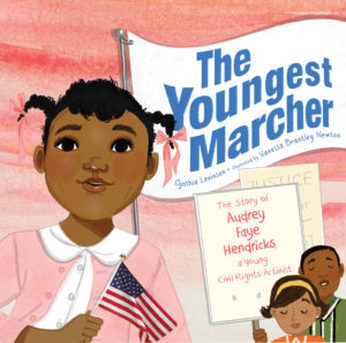 You may remember me writing about Audrey Faye Hendricks several years ago. She was nine-years-old, when arrested and sent to jail during a civil rights march in Birmingham, Alabama, in 1963.
You may remember me writing about Audrey Faye Hendricks several years ago. She was nine-years-old, when arrested and sent to jail during a civil rights march in Birmingham, Alabama, in 1963.I'm excited to tell you about a new book about Audrey, a picture book for primary grade children about an incredibly brave third grader.
The Youngest Marcher , by Cynthia Levinson tells the story of the Birmingham Children's March through the eyes of one little girl. Audrey's family was friends with Dr. Martin Luther King, and she was inspired by his talk about justice.
Dr. King considered Birmingham the most violently racist city in the country, and he spoke in churches there urging blacks to march in protest of segregation, even though they'd be arrested.
"Fill the jails!" said Dr. King.
The plan seemed risky to adults, who feared they'd lose their jobs, be assaulted or possibly killed. Few stepped up.
"Fill the jails!"
When Civil Rights Leader Reverend James Bevel, suggested school children should march and go to jail, Audrey was one of the first to volunteer.
Some four-thousand young people marched, and kept marching until Birmingham's jails were filled to capacity. Audrey spent seven days in custody, the youngest known child arrested.
 Above) Police arrest unidentified child protesters, Birmingham, A.L., 1963. Courtesy Alabama Public Radio. apr.org/post/unity-award-remembering-...
Above) Police arrest unidentified child protesters, Birmingham, A.L., 1963. Courtesy Alabama Public Radio. apr.org/post/unity-award-remembering-...
 The Children's March was powerful, helping gain momentum for civil rights across America. Two and a half months later, Birmingham rescinded its segregation laws, and a year later Congress passed the Civil Rights Act of 1964.
The Children's March was powerful, helping gain momentum for civil rights across America. Two and a half months later, Birmingham rescinded its segregation laws, and a year later Congress passed the Civil Rights Act of 1964.Cynthia Levinson's earlier book We've Got a Job: The 1963 Birmingham Children's March tells Audrey's story in more detail, as well as the stories of three other young marchers.
In my 2014 post, here's what Cynthia had to say about the courage of those young civil rights activists:
When I tell school children today about the brave youngsters in Birmingham, they want to know if I would march, too. Would I sing and pray? Would I face dogs, hoses, and jail? The reason that I know, unfortunately, that I would not is that I did not.
In May 1963, I was an eighteen-year-old high school senior in Columbus, Ohio. In fairness, not a single white person joined the black children during their protests in Birmingham so it’s not completely surprising that I didn’t fly down there. (Some white clergymen and the folk singer Joan Baez did, however.
Nevertheless, to the extent that I paid attention to the news, I was bewildered by what was happening down there. Worse, I hardly paid attention at all. In fact, although I knew about the dogs and the hoses, I didn’t know that it was children who took responsibility for desegregating their city until decades later. Furthermore, although later I did participate in a few protests about political issues I cared about, I chose tame ones where no one was going to get hurt.
Because we know how events in the past have turned out, history in hindsight looks inevitable. Young people today could believe that the children of Birmingham weren’t in any real danger. Beforehand, however, Dr. King was so worried that someone might get hurt or killed that he opposed their actions. Sharing my own embarrassing past with them, I think, makes the threats more real. These were truly dangerous times.
Courage, I hope they learn, does not entail ignoring the dangers but, rather, paying attention to them—and then making a decision about whether or not to proceed. Courage, I’ve learned, is not casual. Courage requires a cause. And, courage draws strength from cooperation.
Thank you, Cynthia! So well said. Learn more about Cynthia and her books here...
 I also want you to meet the very talented illustrator of
The Youngest Marcher,
Vanessa
I also want you to meet the very talented illustrator of
The Youngest Marcher,
Vanessa Brantley Newton. (at left)
She says "The beauty of the book is that little children will walk away with- 'I can do something, no matter how small I am, there is something I can do.' That's empowering."
Vanessa demonstrates how she illustrated the book in a live video interview here.... It's amazing to watch her draw! She's fun to listen to, too.
Vanessa is a prolific illustrator. Check out more of her work here...
Published on June 06, 2017 04:00
May 15, 2017
May 15th, 2017
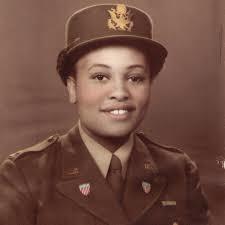 1st Lieutenant Dovey Johnson Seventy-five years ago today President Franklin D. Roosevelt created the Women Auxiliary Army Corps (WAAC), signing a bill that had been passed by Congress amid much bitter debate.
1st Lieutenant Dovey Johnson Seventy-five years ago today President Franklin D. Roosevelt created the Women Auxiliary Army Corps (WAAC), signing a bill that had been passed by Congress amid much bitter debate. This war is not teas, dances, card parties and amusements, Congressman Clare Eugene Hoffman of Michigan said. "You take a poll of the honest-to-goodness women at home, the women who have families, the women who sew on the buttons, do the cooking, mend the clothing, do the washing, and you will find there is where they want to stay—in the homes.”
Apparently, 150,000 women did not want to stay at home, which is how many volunteered for army service during WWII. One of those was Dovey Johnson of Charlotte, North Carolina, one of the first African American woman commissioned as a WAAC officer. Dovey worked as an assistant to Dr. Mary McLeod Bethune, who was the only African American in President Franklin D. Roosevelt's cabinet. When Congress approved the WAAC, Dr. Bethune demanded that black women, not only be allowed to enlist, but to be trained as officers right along beside white women.
At first, Dr. Bethune's logic fell on deaf ears, but she convinced Eleanor Roosevelt that black women deserved equal opportunity, and the First Lady convinced her husband.
Dr. Bethune had long been a family friend, but when Dovey went to work for her, she had no idea the plan was for her to join the army!
Here's an excerpt of an interview with Dovey Johnson Roundtree seven decades later. She talks about rumors the women of the WAAC were meant to be "companions" for the soldiers. This interview was conducted by the National Visionary Leader Project in 2009. You can see the full interview here.
Teachers: Check out this lesson plan you can use with students to look at gender roles in America in the 1940s and how the idea of women serving in the military threatened prevailing attitudes about the duties of women.
Published on May 15, 2017 09:27
May 2, 2017
Unbroken: The Women's Story
 Author Kathryn Atwood I am traveling this week, so I've invited Author Kathryn Atwood to tell you about her book
Women Heroes of World War II: The Pacific Theater.
Author Kathryn Atwood I am traveling this week, so I've invited Author Kathryn Atwood to tell you about her book
Women Heroes of World War II: The Pacific Theater.
She shares the heartbreaking story of three women who, like Louis Zamperini, whose story is told in Unbroken, endured through hardship and torture to survive WWII. Thank you, Kathryn.
My personal images and interest in WWII—as well as the book I was working on--all focused on the European conflict. My Army Air Corps dad and his three brothers had all flown in the European Theater and while I was in high school The Hiding Place [the story of Corrie ten Boom] had come to theaters.
So the two basic images implanted in my mind regarding WWII—tall, dashing, Dutch-American flyboys and a middle-aged Dutch woman who defied the Nazis by hiding Jews—had, apart from Pearl Harbor, made me consider WWII as a primarily European conflict and had compartmentalized the war in my brain under the category of courage, not necessarily endurance.
 Reading the memoirs and biographies of the women featured in what would become Women Heroes of World War II: The Pacific Theater, I came to understand that endurance was precisely what the Pacific War had been for millions of people; not only for American troops fighting an enemy who refused to surrender, but for the civilians unfortunate enough to find themselves in Japanese-controlled territory.
Reading the memoirs and biographies of the women featured in what would become Women Heroes of World War II: The Pacific Theater, I came to understand that endurance was precisely what the Pacific War had been for millions of people; not only for American troops fighting an enemy who refused to surrender, but for the civilians unfortunate enough to find themselves in Japanese-controlled territory.Three women featured in my book perhaps fit more precisely into the Unbroken category because they, like Louis Zamperini, endured intentional physical torture.
Elizabeth Choy, Sybil Kathigasu, and Claire Phillips all suffered at the hands of the Kempetai, the Japanese military police, who, like the German Gestapo, were tasked with weeding out resistance activities.
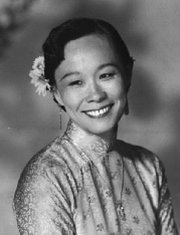 Elizabeth Choy
Elizabeth Choy Elizabeth Choy (left) found herself in their hands inadvertently after she had unknowingly passed radio parts to Allied prisoners in Singapore.
The Japanese were convinced she was part of a larger plot so to obtain the desired confession, they tortured her nearly to death. Deeply religious, she refused to lie, even to save her life.
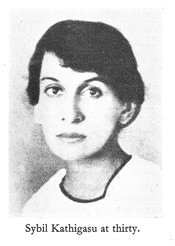
Sybil Kathigasu, on the other hand, was an active member of the Malayan resistance: she provided medical care to local guerilla fighters.
She was caught and taken into Kempeitai custody where one officer named Eko Yoshimura took a special interest in breaking her. He nearly destroyed Kathigasu's body but her will remained intact and she never divulged the information Yoshimura sought.
Claire Phillips, an American member of the Manila resistance, charmed and chatted up Japanese officers in her nightclub, gleaning precious tidbits of intel, then used her earnings to sneak food to starving American POWs.
 Claire Phillips Claire was caught, interrogated, tortured, and starved by the Kempeitai for nearly nine months without betraying anyone.
Claire Phillips Claire was caught, interrogated, tortured, and starved by the Kempeitai for nearly nine months without betraying anyone.
Conversion to Christianity saved Zamperini from his dark, downward spiral but not all American Pacific War POWs fared as well: they suffered far more PTS, alcoholism, premature death, suicide, and divorce in comparison with their counterparts released from German POW camps.
I found a similar trend among the women whose stories I encountered while writing my book. Sybil Kathigasu died three years after the war from complications arising from her beatings. Claire Phillips died in 1960 from alcoholism-related meningitis.
All war creates suffering in the moment and in the aftermath. The Pacific War seemed to be a conflict in which this was intensely true for reasons I’m still sorting out. But whatever the reason, the people who stood up to Japanese fascism deserve respect and remembrance just as much as those who defied the Nazis.
Louie Zamperini once dismissed his war hero status, claiming that mere survival does not make one a hero. Millions of his fans--myself included--profoundly disagree. Surviving the Pacific War was more than enough to earn the designation.
Thanks you, Kathryn.
Learn more about Author Kathryn Atwood and her books here...
Published on May 02, 2017 17:28
April 17, 2017
Unfinished Business!
Imagine devoting your entire adult life to a cause, living more than 90-years, and dying with unfinished business.
Alice Paul believed that men and women should be equal partners in society, and she was behind most 20th Century efforts for women's rights in the United States, including women's right to vote.
Now, close to 100 years after Alice Paul started the fight for an Equal Rights Amendment, women in the U.S. are still second class citizens under the law. (See video below) In August 1917, Alice Paul and nine other suffragists were arrested for protesting in front of the White House. She did not go quietly, believing that equal rights for women would not be gained without extreme measures.
In August 1917, Alice Paul and nine other suffragists were arrested for protesting in front of the White House. She did not go quietly, believing that equal rights for women would not be gained without extreme measures.
Confined behind bars, her only power was refusing to eat. She had resorted to hunger strikes before when arrested in England.
When the forcible feeding was ordered I was taken from my bed, carried to another room and forced into a chair, bound with sheets and sat upon bodily by a fat murderer, whose duty it was to keep me still. Then the prison doctor, assisted by two woman attendants, placed a rubber tube up my nostrils and pumped liquid food through it into the stomach. Twice a day for a month, from November 1 to December 1, this was done. ~Alice Paul Talks, Philadelphia Tribune, January 1910. A new biography of Alice Paul brings the story of this less-well-known suffragist to teenagers in ALICE PAUL AND THE FIGHT FOR WOMEN'S RIGHTS.
A new biography of Alice Paul brings the story of this less-well-known suffragist to teenagers in ALICE PAUL AND THE FIGHT FOR WOMEN'S RIGHTS.
Author Deborah Kops agreed to talk with me about Alice's passion and determination.
Deborah Kops: I am awed by Paul’s courage and her willingness to risk her life to help women win the vote. Her health was fragile, and she jeopardized it on a regular basis when she was young.
Paul went on her longest hunger strike, which lasted three weeks, in 1917, when she was in jail in Washington, D.C. (she went on three hunger strikes years before in the UK).
For most of that time, she was force fed, which is very painful. A hunger strike was her only means of fighting her imprisonment and reminding the public that women wanted the ballot.
She and the other Woman’s Party members who went without food (more than twenty) got plenty of coverage in newspapers around the country, which embarrassed Woodrow Wilson. Less than two months after Paul’s release, Wilson finally announced his support for the woman suffrage amendment.
The amendment was ratified August 18, 1920. Above: Fellow Suffragists protesting Alice Paul's arrest and incarceration for picketing the White House. Photo courtesy of the Historic National Women's Party, Sewell-Belmont House and Museum, Washington D.C.
Above: Fellow Suffragists protesting Alice Paul's arrest and incarceration for picketing the White House. Photo courtesy of the Historic National Women's Party, Sewell-Belmont House and Museum, Washington D.C.
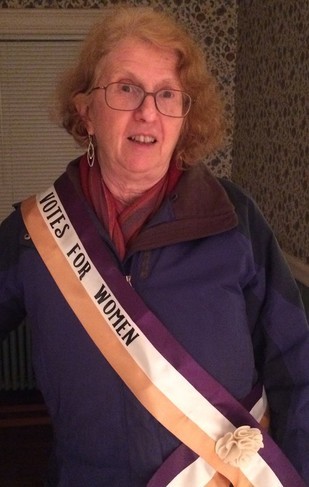 Deborah, this book seems personal to you. (Author pictured below)
Deborah, this book seems personal to you. (Author pictured below)
I became a feminist during the women’s movement of the late sixties and early seventies, which historians call the second wave. And I assumed that the Equal Rights Amendment, which we were fighting for, was written in the sixties. I learned that the amendment was Alice Paul’s idea and that she wrote it in 1923 !
A century later, when Hillary Clinton made her acceptance speech as the first woman nominated by a major political party for the presidency, I was very touched to see her wearing white, the color that suffragists often wore beneath their sashes.
When I joined the Women’s March in Boston in January, I was very proud to wear a sash with the National Woman’s Party colors—purple, white, and gold—over my jacket.
Thank you for taking time for this interview, Deborah, and for writing about this courageous woman!
You can see all of Deborah Kops books at her website here , including The Great Molasses Flood: Boston, 1919 which Kirkus Reviews calls A fascinating account of a truly bizarre disaster.
Back to the Equal Rights Amendment. If you know anyone living in the states colored yellow below...ask them if they know their state has not ratified the ERA.
Then check out the video below (it's less than two minutes long). Feel free to forward this newsletter. Thanks www.equalrightsamendment.org for the map.
Just three weeks ago Nevada became the 36th state to ratify the ERA (45 years to the day after Congress passed it). This year ERA bills have been introduced in the legislatures of Arizona, Florida, Illinois, North Carolina, Utah, and Virginia. Thanks www.equalrightsamendment.org for the map.
Thanks www.equalrightsamendment.org for the map.
Alice Paul believed that men and women should be equal partners in society, and she was behind most 20th Century efforts for women's rights in the United States, including women's right to vote.
Now, close to 100 years after Alice Paul started the fight for an Equal Rights Amendment, women in the U.S. are still second class citizens under the law. (See video below)
 In August 1917, Alice Paul and nine other suffragists were arrested for protesting in front of the White House. She did not go quietly, believing that equal rights for women would not be gained without extreme measures.
In August 1917, Alice Paul and nine other suffragists were arrested for protesting in front of the White House. She did not go quietly, believing that equal rights for women would not be gained without extreme measures.Confined behind bars, her only power was refusing to eat. She had resorted to hunger strikes before when arrested in England.
When the forcible feeding was ordered I was taken from my bed, carried to another room and forced into a chair, bound with sheets and sat upon bodily by a fat murderer, whose duty it was to keep me still. Then the prison doctor, assisted by two woman attendants, placed a rubber tube up my nostrils and pumped liquid food through it into the stomach. Twice a day for a month, from November 1 to December 1, this was done. ~Alice Paul Talks, Philadelphia Tribune, January 1910.
 A new biography of Alice Paul brings the story of this less-well-known suffragist to teenagers in ALICE PAUL AND THE FIGHT FOR WOMEN'S RIGHTS.
A new biography of Alice Paul brings the story of this less-well-known suffragist to teenagers in ALICE PAUL AND THE FIGHT FOR WOMEN'S RIGHTS.Author Deborah Kops agreed to talk with me about Alice's passion and determination.
Deborah Kops: I am awed by Paul’s courage and her willingness to risk her life to help women win the vote. Her health was fragile, and she jeopardized it on a regular basis when she was young.
Paul went on her longest hunger strike, which lasted three weeks, in 1917, when she was in jail in Washington, D.C. (she went on three hunger strikes years before in the UK).
For most of that time, she was force fed, which is very painful. A hunger strike was her only means of fighting her imprisonment and reminding the public that women wanted the ballot.
She and the other Woman’s Party members who went without food (more than twenty) got plenty of coverage in newspapers around the country, which embarrassed Woodrow Wilson. Less than two months after Paul’s release, Wilson finally announced his support for the woman suffrage amendment.
The amendment was ratified August 18, 1920.
 Above: Fellow Suffragists protesting Alice Paul's arrest and incarceration for picketing the White House. Photo courtesy of the Historic National Women's Party, Sewell-Belmont House and Museum, Washington D.C.
Above: Fellow Suffragists protesting Alice Paul's arrest and incarceration for picketing the White House. Photo courtesy of the Historic National Women's Party, Sewell-Belmont House and Museum, Washington D.C.
 Deborah, this book seems personal to you. (Author pictured below)
Deborah, this book seems personal to you. (Author pictured below)I became a feminist during the women’s movement of the late sixties and early seventies, which historians call the second wave. And I assumed that the Equal Rights Amendment, which we were fighting for, was written in the sixties. I learned that the amendment was Alice Paul’s idea and that she wrote it in 1923 !
A century later, when Hillary Clinton made her acceptance speech as the first woman nominated by a major political party for the presidency, I was very touched to see her wearing white, the color that suffragists often wore beneath their sashes.
When I joined the Women’s March in Boston in January, I was very proud to wear a sash with the National Woman’s Party colors—purple, white, and gold—over my jacket.
Thank you for taking time for this interview, Deborah, and for writing about this courageous woman!
You can see all of Deborah Kops books at her website here , including The Great Molasses Flood: Boston, 1919 which Kirkus Reviews calls A fascinating account of a truly bizarre disaster.
Back to the Equal Rights Amendment. If you know anyone living in the states colored yellow below...ask them if they know their state has not ratified the ERA.
Then check out the video below (it's less than two minutes long). Feel free to forward this newsletter. Thanks www.equalrightsamendment.org for the map.
Just three weeks ago Nevada became the 36th state to ratify the ERA (45 years to the day after Congress passed it). This year ERA bills have been introduced in the legislatures of Arizona, Florida, Illinois, North Carolina, Utah, and Virginia.
 Thanks www.equalrightsamendment.org for the map.
Thanks www.equalrightsamendment.org for the map.
Published on April 17, 2017 16:39
April 3, 2017
Disagreement ≠ Disagreeable
 I wish I'd learned as a kid, how to get along with and respect people I disagree with. Maybe then it would be easier now.
I wish I'd learned as a kid, how to get along with and respect people I disagree with. Maybe then it would be easier now.Those early lessons become second nature and we barely think about them. This book is a great story to read with kids and open up the conversation about being friends with people even when your ideas are polar opposites.
I Dissent: Ruth Bader Ginsburg Makes Her Mark , by Debbie Levy
has a list of tributes and prizes as long as my arm. It's a Booklist Editors’ Choice, NCTE Orbis Pictus honor book, on the New York Public Library Best Books for Kids, and more.
I'm in awe of how the author put so much information into forty illustrated pages, included humor, making Ruth so human, and tying it all together seamlessly.
The process of writing a beautiful, succinct, powerful picture book is hidden. It appears effortless. It's not. Believe me. I've tried it.
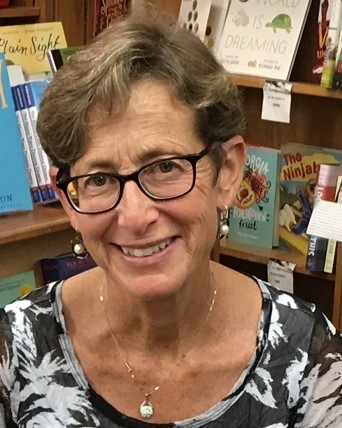 Author Debbie Levy Author Debbie Levy kindly agreed to an interview, and I asked her to share some part, perhaps a crucial step in the process of how she distilled the story of Ruth Bader Ginsburg becoming a Supreme Court Justice in a way that would interest kids.
Author Debbie Levy Author Debbie Levy kindly agreed to an interview, and I asked her to share some part, perhaps a crucial step in the process of how she distilled the story of Ruth Bader Ginsburg becoming a Supreme Court Justice in a way that would interest kids. Debbie Levy: Early on in my research, I realized my theme: that Ruth Bader Ginsburg’s life has been one disagreement after another. I found that she’d been disagreeing with unfairness and discrimination and injustice from the time she was a young girl.
So this theme—that disagreeing doesn’t make you disagreeable and that important change can happen one disagreement after another—was the crucial step in the process of writing this book. (Below: Pages from I DISSENT)
 Debbie Levy: There is a variation on the “I dissent” theme on nearly every spread in the book. “She protested” (as a schoolgirl, to being required to write with her right hand even though she is left-handed).
Debbie Levy: There is a variation on the “I dissent” theme on nearly every spread in the book. “She protested” (as a schoolgirl, to being required to write with her right hand even though she is left-handed). “Ruth objected” (also in school, to the rule that required girls to take home ec, reserving shop class for boys).
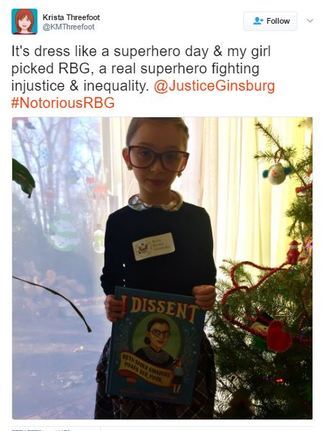 Courtesy Twitter “Ruth disapproved right back” (when people disapproved of her decision to go to law school).
Courtesy Twitter “Ruth disapproved right back” (when people disapproved of her decision to go to law school).“She resisted. And persisted” (when, as a young law school graduate at the top of her class, no one would hire her because she was a woman, a mother, and a Jew). And so on.
The tone is enhanced—and I love this—by Elizabeth Baddeley’s large and emphatic hand lettering of these “dissenting” refrains.
Mary: One of the most powerful parts of the book for me comes near the end, when the character some might call Ruth's nemesis comes into the story.
The illustration shows RBG arguing with Supreme Court Justice Antonin Scalia.
Then on the next page the two justices are parasailing together in France, then riding an elephant like BFF in India.
That inspires me. And challenges me. How can we get along better with people we disagree with?
Debbie Levy: One lesson is to listen: to listen, really listen, to what people on the other side of an argument have to say.
Before his death last year, Justice Scalia was the Supreme Court justice with whom RBG most frequently, and deeply, disagreed. But they neither shouted past each other nor ignored each other. Instead, they shared their conflicting ideas.
They pointed out weaknesses in the other’s arguments. Justice Ginsburg has explained how this helped her: “Justice Scalia nailed all the weak spots—the ‘applesauce’ and ‘argle bargle’—and gave me just what I needed to strengthen . . . [my] opinion.”
The takeaway here: take advantage of a good adversary’s critique.
Thank you, Debbie, I appreciate you taking the time to talk with us. Congratulations on an outstanding book! Check out all Debbie's books here...
Published on April 03, 2017 13:01
March 26, 2017
The Dark Story of America's Shining Women
 So excited today to interview Author Kate Moore talking about courage, and her soon-to-be-released-in-the-US book THE RADIUM GIRLS: THE DARK STORY OF AMERICA'S SHINING WOMEN. (Audio Book cover below)
So excited today to interview Author Kate Moore talking about courage, and her soon-to-be-released-in-the-US book THE RADIUM GIRLS: THE DARK STORY OF AMERICA'S SHINING WOMEN. (Audio Book cover below)
Young women hired to paint glow-in-the-dark numbers on wrist watches in the 1910-20s were (in)dispensable to United States Radium, a manufacturer of one of the hottest new products of the era.
'The first thing we asked was, “Does this stuff hurt you?” And they said, “No.” The company said that it wasn’t dangerous, that we didn’t need to be afraid.’
Catherine Donohue and co-workers died of that "stuff." Their courage established a precedent that led to workers' rights to hold their employers accountable when their job makes them sick.
I asked Kate Moore, what was it like to uncover the details of these women's fight for acknowledgement of their suffering?
Kate Moore: "Well, it was extraordinary. And a real privilege – to feel like I was learning what they’d been through. It was particularly striking because for nearly a century no one had listened to their voices and words that were there in the archives all along. It was shocking to realize how cruelly they had been treated. It was sobering to uncover what they’d suffered physically. And it was inspiring to learn that despite all this they never gave up fighting and were always there for each other."
 During WWI, U.S. Radium produced a high-tech paint containing radium called
During WWI, U.S. Radium produced a high-tech paint containing radium called Undark which allowed U.S. soldiers to read their wristwatches and instrument panels at night.
After the war the company used Undark to manufacture a variety of products from buckles on bedroom slippers to gasoline gauges.
While scientists began to learn more about the dangers of radium, the corporation continued to tell the public it was safe in small quantities.
But the factory women were exposed to much higher levels. Their clothing often glowed when they arrived home from work, and some women painted their fingernails with the fizzy, shining paint. When they began to sicken and die, nobody believed them when they said Undark was killing them.
New hires at U.S. Radium, many of them teenagers, were trained to suck the tip of their paintbrush to achieve a fine point in order to coat radium on the tiny numbers of wrist watches.
Like clockwork, they painted hands and digits on some 200 watch faces a day at five cents a piece, a good income at the time.
The tiny amounts of radium they swallowed before painting each numeral acted like calcium stored away in their bones, except it didn't strengthen their bones, it diseased them, bombarding radiation throughout their bodies.
 Kate (right) learned in her research that male lab technicians working in the very same company must have known something the women didn't. Company chemists used lead screens, masks, and tongs when working with the paint.
Kate (right) learned in her research that male lab technicians working in the very same company must have known something the women didn't. Company chemists used lead screens, masks, and tongs when working with the paint. Five women won their lawsuit against the company in the 1930s, but they were shunned by neighbors, and forty years later men at the company still believed the women had been lying.
 Associate Press photo of Catherine, Tom Donohue and their children. Kate Moore:
I tried to empathise with the women as deeply as I could. Their letters and interviews obviously give an incredible insight into them. So I did feel, as best I could, that I knew Catherine. I had to, in order to write her story.
Associate Press photo of Catherine, Tom Donohue and their children. Kate Moore:
I tried to empathise with the women as deeply as I could. Their letters and interviews obviously give an incredible insight into them. So I did feel, as best I could, that I knew Catherine. I had to, in order to write her story.
There were two things that struck me. The first was how ordinary she was, in a way: a mother, a wife, a friend. A woman who got lonely when no one could visit her in a distant hospital. A woman who got worried when her husband couldn’t find work.
The second, of course, was how extraordinary she was: the way she kept fighting for her children, her husband, her friends.
Catherine Donohue fainted during a court hearing when a doctor described how she had no hope of recovering from radium poisoning.
Later lawyers visited her at home, as she testified from her deathbed.
 Courtesy Chicago Daily Times.
Courtesy Chicago Daily Times.
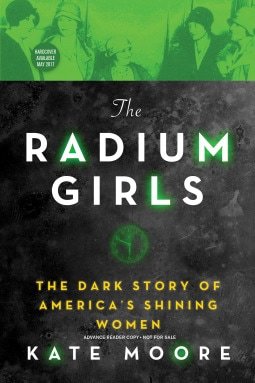 www.amazon.com/Fannie-Never-Flinched-Struggle-American/dp/1419718843Kate Moore:
The photographs of her from June 1938, shortly before her death, show how emaciated she was, yet her spirit burned so strongly inside her, despite the weakening of her body.
www.amazon.com/Fannie-Never-Flinched-Struggle-American/dp/1419718843Kate Moore:
The photographs of her from June 1938, shortly before her death, show how emaciated she was, yet her spirit burned so strongly inside her, despite the weakening of her body.
She was determined never to give up. Journalists talked of their surprise at the passion in her voice because of the frailty of her body. She fought to the death for this cause.
Catherine said her faith sustained her. I think a lot of it was also to do with friendship. She had seen friends die from the same cause that had made her sicken and I think she was determined to hold the company to account.
What these women went through physically was horrific: losing their teeth and jawbones, constantly pus-seeping mouths, broken limbs and backs, huge tumors. They were crippled and killed. And they knew the company was to blame. So I think the sheer injustice of it also fired their courage.
Thank you, Kate! I appreciate you taking the time for an interview.
Five dial painters sued the Orange, New Jersey defense contractor for $250,000 each, but couldn't wait for trial delays and roadblocks engineered by the company. They were dying.
After initial hearings in 1927, the women
accepted a mediated settlement, $10,000 per woman, plus legal and medical expenses, and a $600 per year annuity for as long as they lived. U.S. Radium ended up paying few annuities.
You can pre-order the book here...
Reminder: In celebration of Women's
History Month, I'm giving away a copy of Fannie Never Flinched, a CD of Labor Singer Anne Feeney and a free Skype Author visit to your book group, union meeting, library or school. Enter here...
Published on March 26, 2017 08:15
March 20, 2017
Revealing Another Hidden Figure
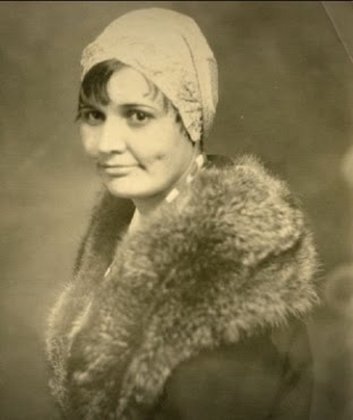 Meet Mary Golda Ross, the first Native American aerospace engineer. (1908-2008)
Meet Mary Golda Ross, the first Native American aerospace engineer. (1908-2008)She learned to read at 3, listening to her father teach her older sister. But it was arithmetic that rocketed this woman into the history books!
More basic, it was the Cherokee commitment to equal opportunity education at a time when most girls were not expected to go to college or have a career outside the home.
Mary was born in Oklahoma on her parents allotment in the foothill the Ozarks. Her great-great-grandfather was a Cherokee Chief, who lead his people over the Trail of Tears.
"Even in the days before women's liberation, the role of Cherokee women has never been a subservient one," Mary said. "Women held high positions in early Cherokee tribal councils, where their advice was heeded not only on matters of policy, but also concerning war strategy."
Mary graduated from high school at 16, and teacher's college at 18. Teaching high school and taking college classes during the summer, Mary earned a master's degree in mathematics.
"[I] didn’t mind being the only girl in math class. Math, chemistry and physics were more fun to study than any other subject,” Mary said.
"I sat on one side of the room and the guys on the other side of the room. I guess they didn’t want to associate with me. But I could hold my own with them, and sometimes did better.”

When WWII broke out, the Lockheed Aircraft Corporation was looking for mathematicians to help resolve problems with the P-38 Lightning fighter plane. Mary applied and was hired.
The P-38 could climb and it doubled as an long-range threat, carrying a larger payload than early B-17s with a range of 1,150 miles. But in a dive, the fighter could destabilize resulting in the deaths of a test pilot and an undetermined number of men who flew the aircraft in combat.
Part of a team working in secrecy, Mary helped fix issues with the P-38 and went on to a career at Lockheed.
 She was one of the founding members of Skunk Works, a super-secret think tank that became Lockheed Missiles & Space Co, and worked with NASA on the Apollo program, the Polaris reentry vehicle, and interplanetary space probes.
She was one of the founding members of Skunk Works, a super-secret think tank that became Lockheed Missiles & Space Co, and worked with NASA on the Apollo program, the Polaris reentry vehicle, and interplanetary space probes.Much of the work of that Lockheed group, including theories and papers by Ross, remain classified.
In the early 1960s, Mary told a reporter she believed women would make great astronauts.
But she said, “I’d rather stay down here and analyze the data.” She offered some great advice for young women, “To function efficiently, you need math. The world is so technical, if you plan to work in it, a math background will let you go farther and faster.”


One of Mary's accomplishments was as an author of the NASA Planetary Flight Handbook Vol. III dealing with space travel to Mars and Venus.
After retiring in 1973, Mary worked to recruit young women and Native American youth into engineering careers.
Though she once mentioned one of her few regrets was spending so much of her life apart from Indian people, upon her death, the Principal Chief of the Cherokee Nation, Chad Smith said, “The accomplishments of Mary Golda Ross epitomize the Cherokee spirit. Her ambition and successes exemplify the importance of education and are evidence of the doors that can be opened through higher learning.”
Mary Golda Ross died in 2008 at 100 years of age. Now don't you think she deserves a movie about her?
Reminder: I'm giving away copies of Fannie Never Flinched in celebration of Women's History Month. And that's not all! Find out all about the prizes and how to enter here...
Published on March 20, 2017 12:08
March 13, 2017
Look Who's Fighting on Today's Front Line
I'm giving away three copies of
Fannie Never Flinched
in celebration of Women's History Month.
And that's not all! Find out all about the prizes and how to enter here... Ai-Jen Poo, Director of National Domestic Workers AllianceIf Fannie Sellins were alive today, where do you think you'd find her? My guess is she'd be working along side Ai-Jen Poo.
Ai-Jen Poo, Director of National Domestic Workers AllianceIf Fannie Sellins were alive today, where do you think you'd find her? My guess is she'd be working along side Ai-Jen Poo.
Four years ago, Newsweek named Ai-Jen to it's 150 Fearless Women list. TIME called her one of 100 Most Influential People in the World.
What does she do? Something many people said couldn't be done. In 2000, she started organizing domestic workers, mostly women, who work in homes carrying for the young and the elderly, cooking and cleaning.
Ai-Jen brought together workers spread out over many private homes, co-founding
Domestic Workers United in New York City.
Her work led to the New York State Domestic Workers Bill of Rights, passed in 2010, it guaranteed domestic workers lawful rights to vacation and overtime pay.
Under Ai-Jen's leadership the union grew into the National Domestic Workers Alliance and expanded operations across the country.
Like Fannie Sellins, Ai-Jen is motivated by compassion...
Marking #DayWithoutAWoman, International Women's Day, March 8, thousands of domestic workers from across the nation skipped work, dressed in red and rallied in the streets. Courtesty Ai-Jen Poo @Aijenpoo TwitterSkipping a day of work means a huge hit to the household budget of low wage workers, and they risk being fired, but domestic workers in America have a history of taking risks like this, Ai-jen Poo wrote for CNN.com.
Courtesty Ai-Jen Poo @Aijenpoo TwitterSkipping a day of work means a huge hit to the household budget of low wage workers, and they risk being fired, but domestic workers in America have a history of taking risks like this, Ai-jen Poo wrote for CNN.com.
In 1881, black washerwomen went on strike in Atlanta and nearly shut down the entire city. Despite losing wages, being arrested and fined for “disorderly conduct” the women stayed off the job for weeks. Standing their ground they won better pay, more autonomy in their work and inspired other low wage workers to strike.
Ai-Jen says many immigrant members of the Domestic Workers Alliance have already risked their lives fleeing poverty, violence and war to bring their children to the U.S., and in the current political climate, simply walking their children to school or going to the grocery store they risk getting caught and deported.
Ai-Jen's suggests. "Let's keep asking the question: 'How can I be more courageous in what I commit to, to match what's at stake?'"
And that's not all! Find out all about the prizes and how to enter here...
 Ai-Jen Poo, Director of National Domestic Workers AllianceIf Fannie Sellins were alive today, where do you think you'd find her? My guess is she'd be working along side Ai-Jen Poo.
Ai-Jen Poo, Director of National Domestic Workers AllianceIf Fannie Sellins were alive today, where do you think you'd find her? My guess is she'd be working along side Ai-Jen Poo. Four years ago, Newsweek named Ai-Jen to it's 150 Fearless Women list. TIME called her one of 100 Most Influential People in the World.
What does she do? Something many people said couldn't be done. In 2000, she started organizing domestic workers, mostly women, who work in homes carrying for the young and the elderly, cooking and cleaning.
Ai-Jen brought together workers spread out over many private homes, co-founding
Domestic Workers United in New York City.
Her work led to the New York State Domestic Workers Bill of Rights, passed in 2010, it guaranteed domestic workers lawful rights to vacation and overtime pay.
Under Ai-Jen's leadership the union grew into the National Domestic Workers Alliance and expanded operations across the country.
Like Fannie Sellins, Ai-Jen is motivated by compassion...
"I often compare great campaigns to great love affairs because they’re an incredible container for transformation."But Ai-Jen is no push-over. "... when we’re trying to transform a fundamentally unequal society...there’s a level of discomfort and conflict that has to happen in order for us to achieve a more loving fate.” She says domestic workers are up for the fight.
Marking #DayWithoutAWoman, International Women's Day, March 8, thousands of domestic workers from across the nation skipped work, dressed in red and rallied in the streets.
 Courtesty Ai-Jen Poo @Aijenpoo TwitterSkipping a day of work means a huge hit to the household budget of low wage workers, and they risk being fired, but domestic workers in America have a history of taking risks like this, Ai-jen Poo wrote for CNN.com.
Courtesty Ai-Jen Poo @Aijenpoo TwitterSkipping a day of work means a huge hit to the household budget of low wage workers, and they risk being fired, but domestic workers in America have a history of taking risks like this, Ai-jen Poo wrote for CNN.com.In 1881, black washerwomen went on strike in Atlanta and nearly shut down the entire city. Despite losing wages, being arrested and fined for “disorderly conduct” the women stayed off the job for weeks. Standing their ground they won better pay, more autonomy in their work and inspired other low wage workers to strike.
Ai-Jen says many immigrant members of the Domestic Workers Alliance have already risked their lives fleeing poverty, violence and war to bring their children to the U.S., and in the current political climate, simply walking their children to school or going to the grocery store they risk getting caught and deported.
Ai-Jen's suggests. "Let's keep asking the question: 'How can I be more courageous in what I commit to, to match what's at stake?'"
"How can I be more courageousFannie Sellins were alive today, she'd be asking us to consider the same challenge. Fannie would be right at home with Ai-Jen Poo and the women and men of the National Domestic Workers Alliance. a Rafflecopter giveaway
in what I commit to,
to match
what's at stake?"
Published on March 13, 2017 06:30
March 10, 2017
Free Book Giveaway to Celebrate Women's History Month
 What would you do for your principles?
What would you do for your principles?Fannie Sellins went hungry and cold and she went to jail. She challenged powerful men and mighty corporations with nothing but her voice, and her ability to bring people together and inspire hope.
When gunmen threatened to kill her, she stood on the picket line strong as steel. For her principles, Fannie died with a bullet to the back.
This astounding story has gone untold for generations. Enter now to win a free copy of Fannie Never Flinched: One Woman's Courage in the Struggle for American Labor Union Rights. Click Here to Enter I'm doing three prize drawings. The first drawing for a copy of FANNIE NEVER FLINCHED will be Friday, March 17, 2017.
Second prize will be a copy of the book, plus an Anne Feeney CD, UNION MAID, including Anne's song about Fannie Sellins.
It brings me to tears every time I hear it. I am not kidding! Listen below. Utah Phillips called Anne, "The best labor singer in North America." The Grand Prize includes the book, the CD, and then there's more!
If you're the grand prize winner, I'll visit your union meeting, book group, library, or classroom via Skype. I'll talk about my ten year research and obsession with Fannie Sellins, how I kept faith in my vision and how FANNIE NEVER FLINCHED came to be the beautiful book that it is! Or, you pick a topic and we'll visit via Skype at a mutually agreeable time. Enter as many times as you want and tell your friends! Click here to Enter Giveaway!
Published on March 10, 2017 00:00
March 3, 2017
Meet the Lady Warrior from Wichita!
"Wall Street owns the country.
It is no longer
a government
of the people, by the people,
and for the people,
but a government of Wall Street, by Wall Street,
and for Wall Street."
 A quote from Occupy Wall Street? No.
A quote from Occupy Wall Street? No.It's Mary Elizabeth Lease speaking 125-years ago! She's also known for telling Kansas farmers to "raise less corn and more hell," but she swears a newspaper made that up.
Mary Lease was the wife of a struggling Kansas farmer, mother of four, and important figure in the Populist movement.
She became famous in the 1880s for her impassioned speeches for women’s suffrage, temperance, and justice for farmers and other working poor.
“You may call me an anarchist, a socialist, or a communist, I care not, but I hold to the theory that if one man has not enough to eat three times a day and another man has $25,000,000, that last man has something that belongs to the first.”
Known as the "Populist lady-warrior from Wichita," Lease mesmerized audiences in Kansas, Missouri, the Far West, and the South with her powerful voice and charismatic speaking style. The brief heyday of populism could not crack the two-party system of U.S. politics, but many of the reforms sought by Populists later became reality.
One of today's populist movements, Occupy Wall Street could have a similar impact, though critics saw it as a leaderless group of disaffected young people with no clear objective or agenda, and little power for change.
 I felt I was witnessing history in the fall of 2011, while in the nation's capital researching my book
Pure Grit
, I snapped photos of the Occupiers at Zuccotti Park.
I felt I was witnessing history in the fall of 2011, while in the nation's capital researching my book
Pure Grit
, I snapped photos of the Occupiers at Zuccotti Park.Occupy protesters popularized the catchphrase "We're the 99%" and spawned similar gatherings across the country in the two months before they were evicted by police from their camp near the New York Stock Exchange.
The protests triggered grass-roots movements to address issues as varied as the student debt crisis to oil pipelines and fracking, police brutality, racism and Bernie Sanders's campaign for the Democratic presidential nomination.
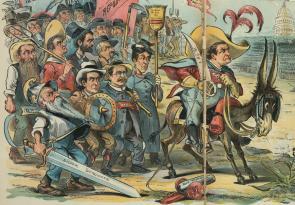 Puck magazine depiction of Mary Lease supporting William Jennings Bryan in the 1896 presidential election. Some historians believe Mary Lease was able to feel and express popular agitation, acting more as a barometer of discontent than an originator and leader of reform.
Puck magazine depiction of Mary Lease supporting William Jennings Bryan in the 1896 presidential election. Some historians believe Mary Lease was able to feel and express popular agitation, acting more as a barometer of discontent than an originator and leader of reform.After initial populist success, Mary seemed unable to cooperate with others in Kansas to build a political base. She refused to support a Populist-Democrat coalition
because she blamed the Democratic Party for the Civil War. Two of her brothers died fighting for the union and her father
died a captive in Andersonville prison.
She may have had her blind spots, but I admire Mary for her courage and perseverance in pursuing a law degree while raising four children and helping her husband run their farm.
Apparently she studied while scrubbing laundry by pinning sheets of notes above her wash tub. Mary was admitted to the bar in 1885, one of very few female
Kansas lawyers.
Her experience of working hard for the American dream and remaining in poverty powered her activism, as it does today's low wage workers demands for a higher minimum wage.
 Micah White
one of the founders Occupy Wall Street says despite how it may have empowered movements like Black Lives Matter, the protests did not stop President Trump from winning election.
Micah White
one of the founders Occupy Wall Street says despite how it may have empowered movements like Black Lives Matter, the protests did not stop President Trump from winning election.White says if protest, if emotional rhetoric, doesn't translate to votes on election day it will not create change. " American activists must move from detached indignation to revolutionary engagement."
If Mary Lease were alive today, she'd be dusting off her old speeches and perhaps figuring out how to turn fiery words into real change.
Published on March 03, 2017 14:25



